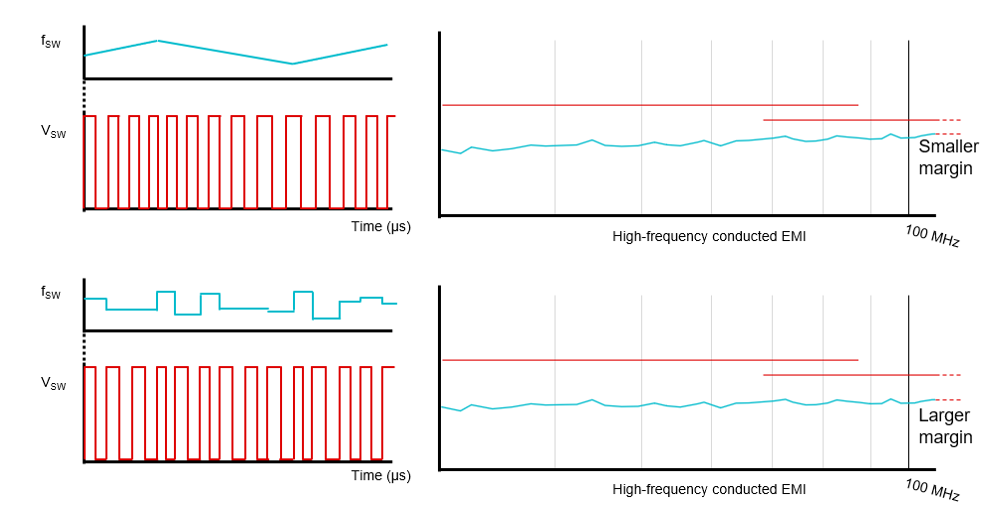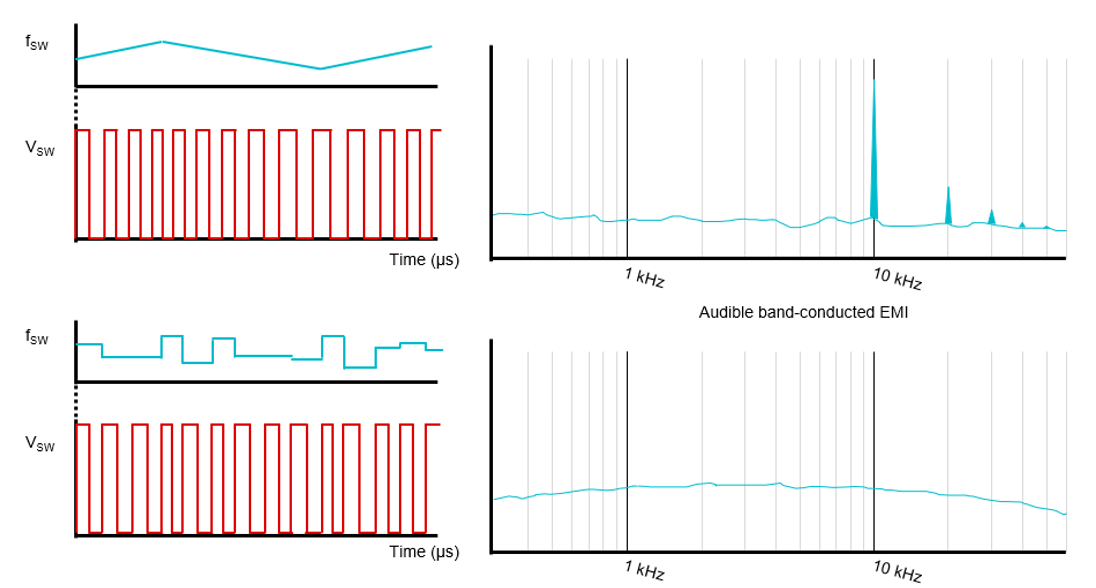SLUP408 February 2022 LM25149-Q1 , LM61460-Q1 , LM61495-Q1 , LMQ61460-Q1
- 1 Introduction
- 2 Defining EMI
- 3 What Causes EMI in a Switched-Mode DC/DC Regulator?
- 4 Existing Passive EMI Filtering Techniques
- 5 Passive Filter Limitations
- 6 AEF
- 7 Spread Spectrum
- 8 DRSS
- 9 True Slew-Rate Control
- 10HotRod? Package Technology
- 11Optimized Package and Pinout
- 12Integrated Capacitors
- 13Conclusions
- 14References
- 15Important Notice
7 Spread Spectrum
Spread spectrum is a control method that dithers the switching frequency to spread the peak levels of EMI. Spread spectrum is most effective at reducing EMI peak levels at the switching frequency and harmonics, resulting in as much as 10 dBμV of reduction.
There are different methods of dithering the switching frequency for different frequency bands. The modulation frequency of dithering usually adds low-frequency noise in the EMI signature. Two traditional methods of modulating the switching frequency are triangular modulation and pseudo-random spread spectrum.
Figure 7-1 shows the modulation waveforms, switching timings and expected low-frequency EMI of both the triangular and pseudo-random spread-spectrum methods. Triangular spread spectrum dithers the switching frequency in a triangular pattern and spreads the fundamental frequency evenly because of the symmetric distribution. Pseudo-random dithers the switching frequency randomly after every switching cycle, which may not weigh each frequency evenly.
 Figure 7-1 Illustration of triangular and
pseudo-random spread-spectrum modulation waveform, switching waveform, and
low-frequency EMI scan.
Figure 7-1 Illustration of triangular and
pseudo-random spread-spectrum modulation waveform, switching waveform, and
low-frequency EMI scan.Triangular spread spectrum performs better at low frequencies because of the even distribution. Pseudo-random spread spectrum performs better in high-frequency EMI measurements, which are sampled in a span of time that may be shorter than the triangular modulation time. As a result, the full triangular modulation index will not modulate the sampled distribution of frequencies, resulting in more high-frequency EMI. See Figure 7-2.
 Figure 7-2 Illustration of triangular and
pseudo-random spread-spectrum modulation and the resulting high-frequency EMI
scans. Because the resolution bandwidth is finer at high frequencies, triangular
modulation does not spread the frequency as much as pseudo random within the
smaller sample time, and has a worse high-frequency EMI signature. Note the
margin between the scans and limit lines.
Figure 7-2 Illustration of triangular and
pseudo-random spread-spectrum modulation and the resulting high-frequency EMI
scans. Because the resolution bandwidth is finer at high frequencies, triangular
modulation does not spread the frequency as much as pseudo random within the
smaller sample time, and has a worse high-frequency EMI signature. Note the
margin between the scans and limit lines.Triangular spread spectrum can introduce audible noise at the modulation frequency and its harmonics. Pseudo-random spread spectrum can also generate noise, but instead of a distinct tone, it is a distributed noise tone similar to white noise. Figure 7-3 illustrates the tone.
 Figure 7-3 Illustration of triangular and
pseudo-random spread-spectrum modulation and low-frequency EMI scans. Triangular
spread spectrum will exhibit a tone at the modulation frequency.
Figure 7-3 Illustration of triangular and
pseudo-random spread-spectrum modulation and low-frequency EMI scans. Triangular
spread spectrum will exhibit a tone at the modulation frequency.